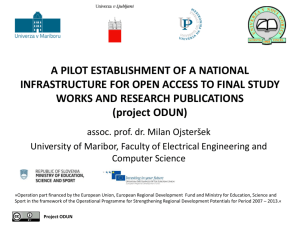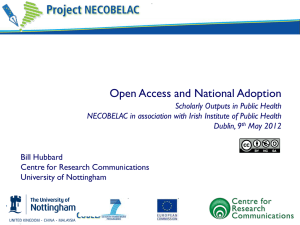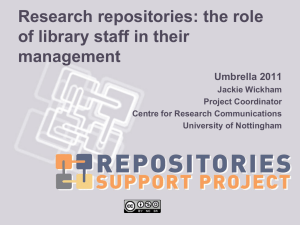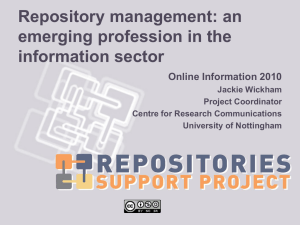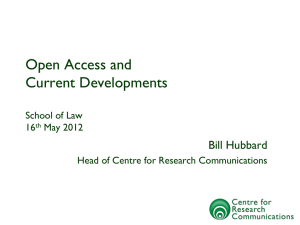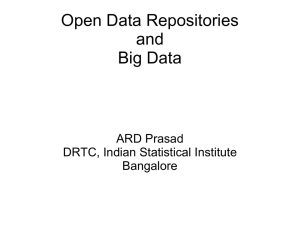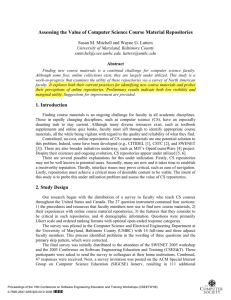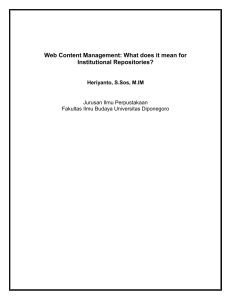Institutional Repositories in India – Present Situation
advertisement
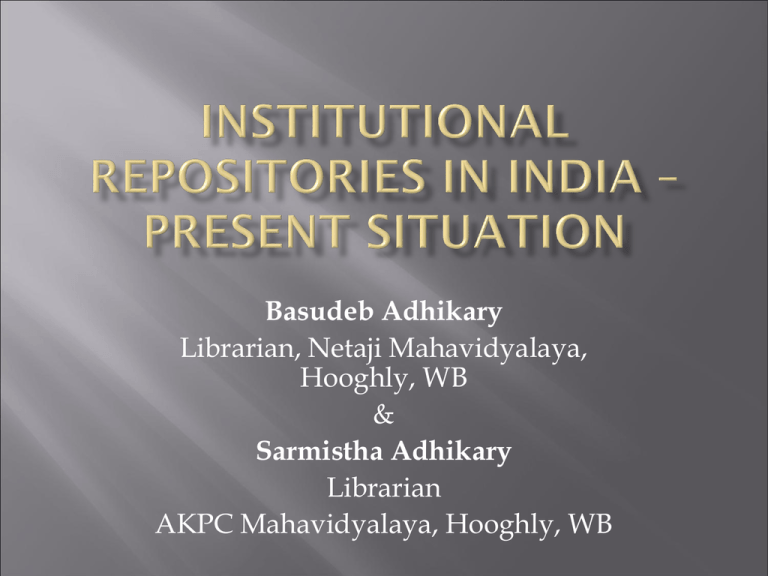
Basudeb Adhikary Librarian, Netaji Mahavidyalaya, Hooghly, WB & Sarmistha Adhikary Librarian AKPC Mahavidyalaya, Hooghly, WB The major way to make knowledge free is Open Access Initiatives. Open Access Initiatives has two major manifestations, firstly Open Access Journals and secondly Open Access Institutional Repositories. This presentation aims to find out the situation of the Institutional Repositories in India. It is digital in nature. Centralized collection of intellectual output of any organization. Apart from intellectual output, administrative documents and teaching materials coming out of the normal academic life may be a part of IR. IR may be single organization based or multiple organization based. Open to members (Full access) or All (to a certain extent or full access) depending upon repository policy. Proper management of intellectual resources in IR. Consistent metadata structure for similar objects in IR. Proper dissemination of resources, long term preservation are the other areas of concern. Establishment of IR is beneficial to all stakeholders of the organization. The benefits may be four pronged. Benefits to the AUTHORS (contributors). Benefits to the INSTITUTION (sponsoring body). Benefits to the USERS (beneficiary). Benefits to the LIBRARY AND INFORMATION CENTERS (facilitators). Instead of scattered in different databases, all the intellectual output (created in his institutional life!) of an individual are kept in a well organized way in a single place. Submission to IR increases visibility, thereby inviting and increasing citation of an article. Well preserved and permanently accessible to all. Increase the global visibility of the intellectual output of the institution. Act as an advertising tool for the institute. When administrative records are submitted in the IR, organizational history is well preserved. A knowledge bank of the institute can be created by accumulating all the works of the intellectual capability. User can browse, search the documents submitted to an IR freely. In some cases users can access the full text, in some can access partially. In case of partial access, users can avail ‘Request a copy’ service. Gray literature like teaching materials, unpublished documents can be accessed from the IR. A librarian feels embarrassed when he can not satisfy the user’s need. In today’s library world the budget is shrinking and document (print & Online) price is increasing. The embarrassment continues. Online journals and institutional repositories can save the day for him. Libraries can assume greater role of reaching global clientele through institutional repositories. As per Registry of Open Access Repositories (ROAR), there are 65 repositories in India. As per Open Directory of Open Access Repositories (OpenDOAR), there are 51 repositories in India. India stands second in Asia after Japan (89). (ROAR information) India stands third after Japan (135) and Taiwan (58). (OpenDOAR information) We choose 60 IRs for our study. Among 60 chosen IRs, 15 cannot be opened during the study. Indian Institute of Science Open Access repository is the first IR in India started in 2004. Among 45 IRs, 3 contain exclusively electronic thesis and dissertation. (Vidyanidhi, etd@IISc, Mahatma Gandhi University Thesis Online) The largest repository is Indian Academy of Science Publication of Fellows (39,300 documents) The smallest IR is WHO India Health Repository. (19 documents) 21 IR s are multi disciplinary in nature. 18 IR s deal exclusively on science technology and allied subjects. 2 IR s contain document regarding library and Information Science and 1 repository each for Developmental studies and Literature. 2 IR s namely Vidya Prasarak Mandal and eGyankosh contains exclusively with teaching material. Regarding repository software, 11 are using Eprints software, 33 are using DSpace software and only 1 is using Nitya software. Among 45 repositories, 41 repositories allows ‘Staff only’ submission. Other 4 repositories allow authors not associated with institute to submit document to the repository. Among 45 IR s consulted, 4 have not provided clear submission policy Regarding accessing the documents, all the repositories provide browsing and searching facility to its users irrespective of affiliation to the organization. 5 institutional repositories do not allow outsiders to access full text of the documents. 33 repositories allow outside users full / partial access to the full text of documents with or without registration. 8 repositories have not any stated access policy in their web sites. World ranking of 1222 repositories are done by www.webometrics.info . Only 18 Indian institutional repository featured in this ranking eprints@iisc being at the 106th position in ranking. Among 60 repositories studied, 15 can not be accessed, they may be available in intranet or LAN. This is contrary to open access initiative. Universities feature in the list of IR rarely in comparison to research institutes. IR on social science or humanities subjects are rare to find. Only 18 IR get their place among 1222 repositories globally ranked is not a fair picture. The development of IR s in India is fast and many institutes are taking up initiatives to set up them. UGC released ‘Regulations 2005’ for submission of metadata and doctoral thesis in electronic format, so that Electronic Thesis and dissertation repository can be made easily. The prospect of Indian IR s are bright. Libraries can hope now to serve their clientele in more better fashion.


